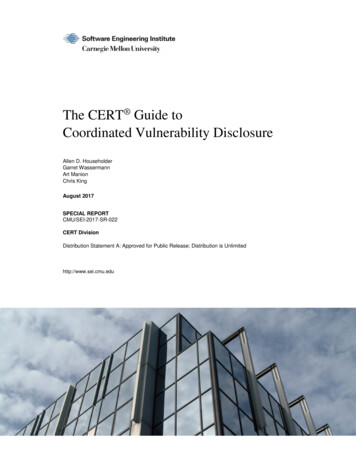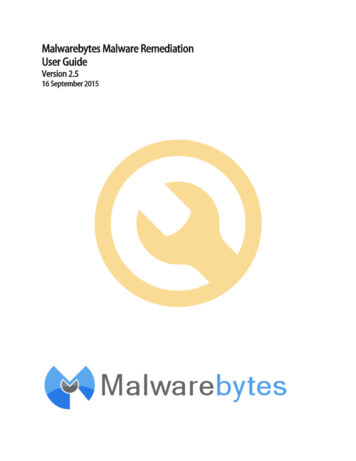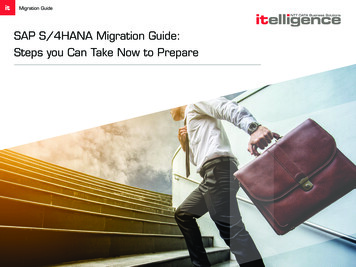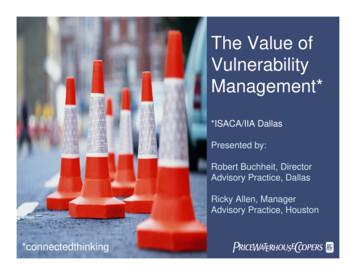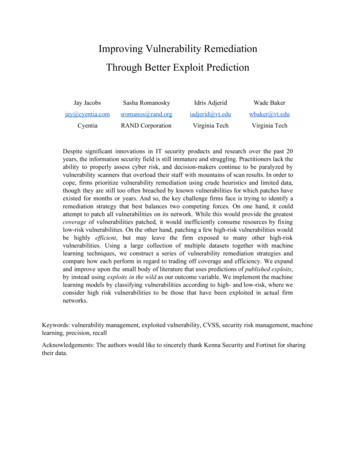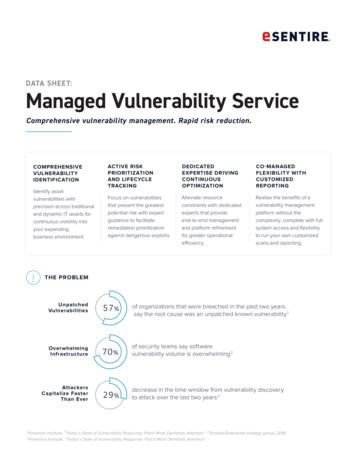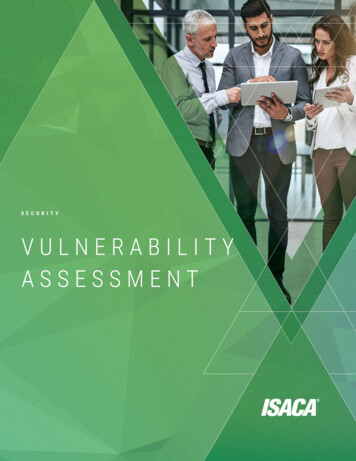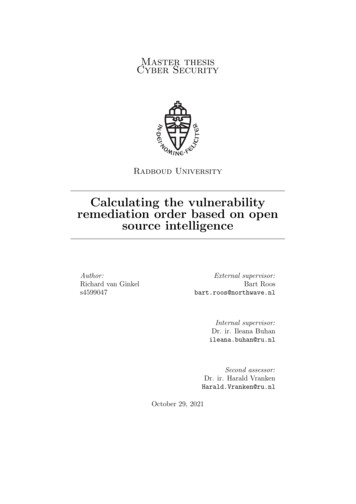
Transcription
Master thesisCyber SecurityRadboud UniversityCalculating the vulnerabilityremediation order based on opensource intelligenceAuthor:Richard van Ginkels4599047External supervisor:Bart Roosbart.roos@northwave.nlInternal supervisor:Dr. ir. Ileana Buhanileana.buhan@ru.nlSecond assessor:Dr. ir. Harald VrankenHarald.Vranken@ru.nlOctober 29, 2021
AbstractOrganizations use vulnerability scans to gain insight into the level of securityof their digital infrastructure. Results of such a scan are often scored usingCommon Vulnerability Scoring System (CVSS). This regularly results inan overwhelming amount of vulnerabilities that are scored high or critical,which makes it difficult to determine which vulnerability should be remediedfirst.In this research project, we propose a new score calculation methodwhich helps select the best follow-up actions with the most impact on thesecurity level of the organization. We develop three optional calculationmethods that we apply on real vulnerability scanning data. To validate theresults, we conduct a survey on experts in the field. Analysis of the resultsof the survey showed that taking into account the reachability of vulnerabilities and the existence of an exploit improves the scoring of vulnerabilitiessignificantly. Our proposed method that combines those two aspects canhelp experts in the field of cyber security selecting which vulnerabilities toremedy first.
Contents1 Introduction22 Preliminaries2.1 Common Vulnerability Scoring System2.1.1 Base metrics . . . . . . . . . .2.1.2 Temporal metrics . . . . . . . .2.1.3 Environmental metrics . . . . .2.1.4 Vectors and example . . . . . .2.1.5 Version 1 and version 3 . . . .44566783 Related Work3.1 CVSS . . . . . . . . . . . . . . . . . . .3.2 Remediation score calculation . . . . . .3.3 Risk assessment . . . . . . . . . . . . . .3.4 Related work and our research question.991213144 Methodology4.1 Developing the methods . . . . . .4.1.1 Data collection . . . . . . .4.1.2 Parameters of our methods4.1.3 Objectives . . . . . . . . . .4.1.4 Optional methods . . . . .4.2 Validating our optional methods .4.2.1 Survey . . . . . . . . . . . .4.2.2 Hypotheses . . . . . . . . .4.2.3 Results of the survey . . . .4.3 Optimal calculation method . . . .1515151618192525252630.5 Conclusions32Appendices361
Chapter 1IntroductionIn 2020, over eighteen thousand new vulnerabilities have been reported inthe National Vulnerability Database (NVD)1 , which is the result of the increasing trend seen over the past years. Vulnerabilities can be exploitedby malicious actors to gain access to devices and data, or perform otherunwanted actions.Because of this, organizations want to minimize the number of vulnerabilities in their digital infrastructure. To this end, organizations can scantheir infrastructure for vulnerabilities, or let others do so for them, usingscanning tools. Such a scan will result in a list of vulnerabilities found,together with the severity score of the vulnerability. These scores are commonly calculated using the Common Vulnerability Scoring System (CVSS)2 ,or a calculation method based on CVSS. This way, one can obtain insightinto the vulnerabilities that have the highest technical severity.However, most organizations will face problems in this process. CVSSis limited to technical severity, while the context of the organization andthe vulnerability are relevant. Next to that, too many of the found vulnerabilities are scored high or critical. Using version 2 of CVSS, which dividesvulnerabilities into the categories low, medium and high, one-third of thevulnerabilities is scored as high, according to the NVD Dashboard3 . CVSSversion 3 introduced the category critical. More than half of the vulnerabilities found are scored either high or critical when using this new version ofCVSS. This number of high or critical vulnerabilities overwhelms organizations in their mission to keep the digital infrastructure secure.In the current way of working, someone analyses the results of a vulnerability scan and selects the most important vulnerabilities out of thevast number of high-scored vulnerabilities. These selected vulnerabilitiescan then be remedied first. The process of analyzing the list of ard22
vulnerabilities and selecting the most important ones is time-consuming.Ideally, organizations would periodically have their infrastructure scannedfor vulnerabilities. The outcome of these scans would be a short and manageable list of remedies against the vulnerabilities with the biggest potentialimpact on the organization. Together with managing and solving these vulnerabilities, this forms the concept of vulnerability management.However, in vulnerability management, most vendors use their own vulnerability and remedy score calculation method. Such a method is based ona version of CVSS. An optimal method is not yet found and vendors are stillworking to improve their method. How these calculations are designed andwork is unclear, since the vendors do not publish their methods. Becauseof this, open research on this problem is desired. In this research project,we propose a risk and remedy score calculation method that is suitable forvulnerability management, with additional information on the vulnerabilitytaken into account. We formulate this problem as the following researchquestion:Can we develop a risk scoring method that helps a human expertselect vulnerabilities for remediation?The goal of this thesis is to find a suitable method based on actualvulnerability scan data. To this end, we develop several options and conducta survey among experts to establish the best option.To answer our research question, we explain different CVSS versions inchapter 2. Research related to our research question is discussed in chapter3. We found that there has been quite some research on how to build orimprove CVSS, however, this thesis takes a different perspective. In chapter4 we elaborate on the research problem and our optional methods whichare applied to vulnerability scan data and the survey that we conducted.Next to that we propose a calculation method based on the results of thesurvey. In the conclusion, which can be found in chapter 5, we summarizeour findings.3
Chapter 2Preliminaries2.1Common Vulnerability Scoring SystemThe Common Vulnerability Scoring System, abbreviated as CVSS, is a framework that is widely used to score vulnerabilities. Using three different metricgroups, which will be discussed in the following subsections, one can determine the technical severity of a vulnerability. Calculating using these groupswill result in a score in the range of zero to ten. The scores are commonlycategorized as low, medium or high, for CVSS version 2. Low covers a scorefrom 0.0 to 3.9, medium from 4.0 to 6.9 and high from 7.0 to 10.0. In version 3, the categories none and critical are added, so the division is doneslightly differently. A score of 0.0 is categorized as none and scores 9.0 to10.0 are categorized as critical. The remaining scores are all still in the samecategory as was the case with version 2 of CVSS.The framework is developed by the National Infrastructure AdvisoryCouncil (NIAC)1 and launched in 2005. After that, further development hasbeen done by the Forum of Incident Response and Security Teams (FIRST)2 ,an organization that was formed as a response to one of the first big security incidents. As stated on their website, ”FIRST aspires to bring togetherincident response and security teams from every country across the worldto ensure a safe internet for all.” FIRST developed a second and a thirdversion and released those in 2007 and 2015, respectively.The second version3 is most common, which is why we discuss this version below. For our research, we will use CVSS version 3 as a building blockwhen it is available, since it contains improvements with respect to version2. CVSS version 14 and CVSS version 35 are slightly different compared toversion 2, as described vss/v3.1/specification-document24
2.1.1Base metricsAs said, CVSS consists of three metrics groups, of which the base metricgroup is the first one. The base metrics deal with the intrinsic and fundamental characteristics of a vulnerability. These characteristics are notaffected by time or environments. This metric group consists of six metrics: Access Vector (AV): reflects how the vulnerability is exposed. Access Complexity (AC): reflects the complexity of gaining accessto the vulnerability. Authentication (Au): measures the number of times an attackermust authenticate to exploit the vulnerability Confidentiality Impact (C): measures the impact on confidentiality Integrity Impact (I): measures the impact on integrity Availability Impact (A): measures the impact on availabilityAll of these metrics are assigned one of the three possible scores for themetric. For AV, these possible scores are shown below in the example. ForAC these scores are high, medium and low. Au has multiple, single and noneas possible scores. For the metrics C, I and A, the possible scores are none,partial and complete. Each of these scores corresponds to a value, as can beseen below for the AV, which is shown as an example:Acces VectorValueRequires local access0.395Adjacent network accessible0.646Network accessible1.0For a vulnerability that is only reachable when one has local accessto the device the vulnerability is on, the value in equation (2.3) is 0.395.This is the lowest possible value, since a vulnerability is more problematicwhen accessible via the network. With the values for the five other metrics,together with the AV described above, one can calculate the CVSS basescore, which is rounded to one decimal, as follows:BaseScore ((0.6 Impact) (0.4 Exploitability) 1.5) f (Impact) (2.1)Impact 10.41 (1 (1 C) (1 I) (1 A))(2.2)Exploitability 20 AV AC Au(2.3)5
f (impact) 0 if Impact 0, 1.176 otherwise2.1.2(2.4)Temporal metricsIn the temporal metrics group, three metrics are presented. These metricsdeal with how the threat posed by a vulnerability changes over time. Thethree metrics are: Exploitability (E): measures the current state of exploit techniquesor code available. Remediation Level (RL): measures the level at which a remedy forthe vulnerability exists. Report Confidence (RC): measures the degree of confidence in theexistence of the vulnerability and the details known.A score is assigned to these metrics as well. However, for the temporalmetrics, four or five possible scores exist. We see that for the RL, there arefive possible scores, each with a value assigned to it, as can be seen in ed1.00Using the values of the three metrics, the Temporal score, which isrounded to one decimal, can be calculated as:T emporalScore BaseScore E RL RC2.1.3(2.5)Environmental metricsLastly, the environmental score can be calculated using the metrics in theenvironmental metrics group. This group contains five metrics, which dealwith the environment of the vulnerability, i.e. the organization in which thevulnerability exists and its stakeholders. The metrics are: Collateral Damage Potential (CDP): measures the potential forloss of life or physical assets through damage or theft.6
Target Distribution (TD): measures the proportion of vulnerablesystems. Security Requirements (Confidentiality Requirement (CR),Integrity Requirement (IR), Availability Requirement (AR)):enables an expert to customize the calculation based on the organization’s requirements for confidentiality, integrity and availability. Thesethree requirements can all be set at High, Medium, Low and Not Defined.It is important to note the difference between the impact on and therequirements for confidentiality, integrity and availability. In the base metricgroup confidentiality, integrity and availability deal with measuring howthose criteria are violated within the system where the vulnerability is in.In the Environmental metric group, one can use confidentiality, integrityand availability requirements to ensure, for example, that an infringementof confidentiality will result in a higher score when the organization seesconfidentiality as an important requirement.After all the metrics have been scored and assigned a value, we cancalculate the Environmental score using the following formulas:EnvironmentalScore (AdjustedT emporal (10 AdjustedT emporal) CDP ) T D(2.6)AdjustedT emporal T emporalScore recomputed with the BaseScore0 sImpact sub equation replaced with the AdjustedImpact equation(2.7)AdjustedImpact min(10, 10.41 (1 (1 C CR) (1 I IR) (1 A AR)))2.1.4(2.8)Vectors and exampleThe scoring of a vulnerability can also be expressed as a vector. In the case ofCVSS, a vector is a string that consists of all the information with which thescore was calculated. We can use base, temporal and environmental vectors.The string consists of the assigned score for each metric, concatenated witha slash between them. For example,AV:L/AC:M/Au:N/C:N/I:P/A:Cstands for a base score where the metrics are scored as follows, with thevalues that belong to the scores:7
Access Vector (AV): Local access: 0.395 Access Complexity (AC): Medium: 0.61 Authentication (Au): None: 0.704 Confidentiality Impact (C): None: 0.0 Integrity Impact (I): Partial: 0.275 Availability Impact (A): Complete: 0.660When we fill in these values in equation (2.1) and its sub-equations we sawat subsection 2.1.1, we get:BaseScore ((0.6 7.843935) (0.4 3.392576) 1.5) 1.176 5.4 (2.9)Impact 10.41 (1 (1 0.0) (1 0.275) (1 0.660)) 7.843935 (2.10)Exploitability 20 0.395 0.61 0.704 3.392576f (impact) 1.1762.1.5(2.11)(2.12)Version 1 and version 3As discussed above, the second version of CVSS is slightly different thanversions 1 and 3.The difference between version 1 and version 2 is that version 1 does notuse the security requirements in the calculation of the environmental score.Instead, the environmental score is calculated based on only the CollateralDamage Potential and the Target Distribution.Version 3 added two metrics in the base metric group. User Interactionand Scope are added to the equation. User Interaction describes whether auser, other than the attacker, is needed to perform one or more actions beforethe vulnerability can be exploited. The Scope captures whether exploitingthe vulnerability affects other systems or applications than the one that thevulnerability is in. An attacker may be able to compromise other systemsvia an entry point in one system.8
Chapter 3Related WorkIn this chapter, literature related to our research problem is discussed. Asdescribed in the introduction, we propose a method which helps select thevulnerability remediations that have the biggest impact. To this end, research into related topics is reviewed below. In this chapter we review articles on the Common Vulnerability Scoring System (CVSS) first. After that,research on remediation score calculation is discussed, followed by researchon the concept of risk assessment. Lastly, our research question is comparedto the studies discussed below.3.1CVSSThe Common Vulnerability Scoring System, abbreviated as CVSS, is themost commonly used standard for assessing the severity of vulnerabilities incomputer systems. Because of this, we discuss relevant research related toCVSS in this section.Singh et al. [11] researched the impact of the temporal metric group andthe environmental metric group of CVSS. As described in chapter 2, thesetwo metric groups are optional. They can be used to calculate a risk scorebased on additional information on the presence of exploits of the vulnerability and characteristics of the organization in which the vulnerability ispresent. Singh et al. [11] conclude that the use of the temporal metric groupand the environmental metric group results in a more effective way to evaluate the risk level of a vulnerability, and thus, that the use of these metricsis useful in system security. Because of this, we know that the elements usedin these metrics must be considered in our method as well. We can not usethese metrics as a whole, because our scanning tool, as well as the onlinesources that we consult, do not offer the information of these metric groups.Doynikova and Kotenko [2] developed a CVSS-based risk assessmenttechnique. The technique takes variables into account as the attack probabilities, impact of the attack and potential financial loss of the attack. Ex-9
periments on their test environment have been done for those three variablesseparately. The experiments resulted in a tool that combines the three different aspects to get a more accurate assessment of the security situation.This research focuses on known attacks and how to defend against them.In other words, known attacks are used as input, and for each of these iscalculated how likely an actual attack on the given environment is. Basedon these outcomes, one can then select what countermeasure should be selected. However, in our research, we use vulnerabilities as the basis of ourmethod. Our goal is not to select a countermeasure against an attack, butrather to remedy the vulnerability that made the attack possible. Becauseof this, the tool proposed in the paper is not suitable for our research.The paper of Wang et al. [13] proposes an improved version of CVSS.They see the scoring done with the temporal metric group and the environmental metric group as subjective. Because of this, the environmentalmetrics are not used in the proposed improvement, and the base metricsand the Temporal metrics are slightly altered. For the base metrics, Wanget al. [13] added the type of the server and the operating system on ahost in the calculation. For the temporal metric group, two known distributions, the Pareto distribution and the Weibull distribution, are used tocalculate the exploitability and the remediation level of a vulnerability. TheReport Confidence, which ’measures the degree of confidence in the existenceof the vulnerability and the credibility of the known technical details’1 , is notused, since it is seen as subjective and the standard value does not influencethe outcome. They illustrate their changed method by a small experiment,showing that their method is more accurate and credible. This research canbe useful for our own method. In case that there is no exploit or remediationknown, we can use the distributions to calculate an estimate.Fruhwirth and Mannisto [6] used the same two distributions, the Paretodistribution and the Weibull distribution, to improve the temporal metrics,which results in the same method for these metrics as proposed by Wanget al [13]. However, Fruhwirth and Mannisto [6] were able to improve theenvironmental metrics as well. This was done by conducting a survey amongsecurity managers of different companies. The result was that availabilitywas ranked as most important, while integrity was seen as least important.The results of this survey were translated into weights of the metrics in theenvironmental metrics of CVSS. With these improvements, they were ableto bring down the score by 0.5 on average. This results in fewer criticalvulnerabilities as a result of a scan. A decrease of 76 percent was seen,which makes it easier to distinguish the most important vulnerabilities fromthe others. This research had the goal to improve the temporal metricsof CVSS. Our thesis aims to enrich the base metrics of CVSS with extrainformation found using open source tion-document10
Houmb et al. [7] use the information given by CVSS and use it asinput for a Bayesian Belief Network. This means they do not calculatea risk score, but rather use the variables of a risk score as input. Withthis input, estimates on the impact and the frequency of a vulnerabilitybeing exploited are made. However, both hard and soft evidence is usedas additional input. This results in a more subjective method, which isundesirable for our research.Scarfone and Mell [10] analyzed CVSS version 2. The newer versionwas compared to the first version of CVSS. They found that the scoresthat are calculated with the second version are higher on average, but moredistributed. Scarfone and Mell mention other possible improvements, butstress that it is important to examine whether increased accuracy of an improvement is worth the added complexity in the calculation method. Thisresearch tells us that additions made to CVSS in the second version are interesting for our method, as long as it is possible to automate the calculationson these additional variables.Elbaz et al. [3] researched the problem that newly disclosed vulnerabilities offer regarding CVSS. After a vulnerability has been disclosed, it willtake time before a CVSS score for the vulnerability has been established,since this is done by human analysis of the vulnerability. In this period oftime that no CVSS score, together with the information in the CVSS vector, is known, automated tools face problems handling such vulnerabilities.To this end, Elbaz et al. propose a method that estimates the CVSS scoreand vector, based on the human-readable description of the vulnerability.This research can help when applying our methods to new vulnerabilities.However, the scores that will be calculated with their proposed methods areproblematic in the same ways as scores calculated with the standard CVSS.In the research of Murthy [9], the correlation between CVSS scores invulnerability disclosures and patching is analyzed. This analysis was basedon the health care sector of the United States of America. The paper statesthat no significant relation between the CVSS score and the frequency ofpatching could be found. This indicates that the current use of CVSS is notsuitable for vulnerability management. One of the aspects that can causethis lack of relationship, is the fact that CVSS does not account for safety,according to Murthy.Spring et al. [12] discuss whether CVSS needs to be changed. Theyconclude that this is the case, because CVSS scores severity and not risk,while it is used as a risk score on many occasions. Next to that, the failureto account for context and consequences in CVSS is problematic accordingto Spring et al. Suggestions on fixing these problems are made. Contextand consequences should be added to the equation, which is what we aimto do in our methods. Next to that, any proposed improvement should beaccompanied by a study of the consistency of humans scoring using it. Thisis what we aim to do with the survey conducted on experts in the field of11
cyber security. Thus, the research of Spring et al. explains clearly why theproblem that we aim to solve is relevant. Next to that, their suggestionsvalidate the approach that we used to solve our research problem.3.2Remediation score calculationThe goal of this line of research is to develop a calculation method to findthe vulnerability remediations that have the biggest impact on the securitylevel of an organization. Research on this specific topic has barely beendone. However, below we will discuss an article that is most closely relatedto our research problem according to our findings. The contributions to thefield will be reviewed, and comparisons to what we contribute in additionwill be made.Farris et al. [4] developed a vulnerability management strategy. To thisend, they used two metrics, i.e. time-to-vulnerability remediation (TVR)and total vulnerability exposure (TVE). TVR indicates the time betweenthe detection and remediation of a vulnerability. The TVE is calculatedbased on multiple variables of the vulnerabilities, such as age, the numberof months a vulnerability has persisted and severity, where CVSS is used forthe latter. These variables are multiplied by a weight, which is chosen by asystem operator. Because of this, these values are rather subjective.The vulnerability score is then multiplied by a scalar value, which is alsodetermined by the system operator. The results of this multiplication, whichare called mitigation utilities, for the vulnerabilities that are not mitigatedyet, are then added. The result of this sum is the TVE. The goal of thispaper is to plan the workload of an analyst in such a way that the TVE andTVR are reduced. Farris et al. use estimations on how many hours it willtake to remediate the vulnerability. Since it is impossible to be sure of this,and the research focused on available time more than on the importance ofthe vulnerability, there is a need to search for different approaches. Becauseof this, our thesis can provide relevant insights into the field of cyber security.TVR is closely related to the research of Chauhan and Pancholi [1]. Theydescribe a theory on availability, which consists of the following concepts: mean time-to-failure (MTTF): This describes the mean time that asystem will run before a failure occurs. mean time-to-repair (MTTR): This describes the main time that ittakes to repair the system after a failure occurs. This is similar to theTVR from the research of Farris et al. mean time-before-failure (MTBF): This is the sum of MTTF andMTTR, which describes the mean time between two failures.12
3.3Risk assessmentAn important aspect of our research question is making cyber security measurable. The book How to measure anything in cybersecurity risk by Hubbard and Seiersen [8] was studied, in hope to help us answer this part ofour research question. This book focuses on making the assessment of cyberrisks measurable. The main idea behind the methods proposed is to adjustthe standard risk matrix that is commonly used. This matrix has likelihoodand impact on the axes. Globally seen, a risk with a high impact and ahigh likelihood gets rated as a high risk and a risk with a low impact and alow likelihood gets rated as a low risk. In between, there is a category formedium risks for other combinations of impact and likelihood.The book suggests changing the likelihood from a score from one to five,to an estimate of the chance in a percentage of an event happening in achosen period of time. For example, a security expert would state that anevent has a 10% chance of happening in the next 12 months. Instead ofimpact scored from one to five, the book focuses on monetized loss. Thegoal here is to estimate a 90% confidence interval for this loss. For example,an expert would estimate that, if the event occurs, there is a 90% chancethat the monetized loss is between one and eight million dollars. Using aMonte Carlo simulation one can then calculate a curve that represents theexpected loss of an organization based on the likelihood and impact of anevent. Based on this expected loss, one can select mitigation for an event.This book proposes a method to make risk more measurable. However,the underlying problem is still the same. The method completely relies onthe estimates of an expert for each vulnerability. The goal of our researchproject is to propose an automated method based on scan data. Because ofthis, the proposed methods in the book do not answer our research question.13
3.4Related work and our research questionIn our introduction we formulated our research problem as the followingquestion:Can we develop a risk scoring method that helps a human expertselect vulnerabilities for remediation?Above we saw that research has been done that is related to this researchquestion. However, most of the discussed studies were aiming to solve another problem.The research of Singh et al. [11] tells us which are the important parameters for the calculation method we propose.The research of Wang et al. [13] is one of the building blocks of ourproposed method. The distributions used there are useful for our optionalmethods when no other information on the vulnerabilities can be found.Fruhwirth and Mannisto [6] aim to include the context of a vulnerabilityin the equation, which is similar to our goal. However, they use a differentapproach to do so.Elbaz et al. [3] aimed to solve a problem that is outside of our scope,i.e. new vulnerabilities on which little information is known. However,their proposed method could be combined with our optional methods, whichwould allow us to add such new vulnerabilities to our scope.Spring et al. [12] discuss the problem that we try to solve in this thesis.They conclude that it is a problem that should be solved, and suggest howthe problem can be solved. One of their suggestions is researched in thisthesis.All in all, we see that some attempts to answer our research questionhave been made. However, the problem is still not solved and thus remainsrelevant. Because of this, our different approach is of added value in thesearch for a solution to the research problem.14
Chapter 4MethodologyIn this chapter, we will elaborate on our methodology. This chapter is divided into three sections. The first section discusses how the optional methods are developed and describes the requirements an ideal method shouldmeet. The second section describes the survey that was conducted and theresults that the survey gave. After that, these results are used to proposeour optimal approach.4.14.1.1Developing the methodsData collectionOur data is collected using Rapid7’s Nexpose1 , which is professional vulner
2.1.2 Temporal metrics In the temporal metrics group, three metrics are presented. These metrics deal with how the threat posed by a vulnerability changes over time. The three metrics are: Exploitability (E): measures the current state of exploit techniques or code available. Remediation Level (RL): measures the level at which a remedy for


